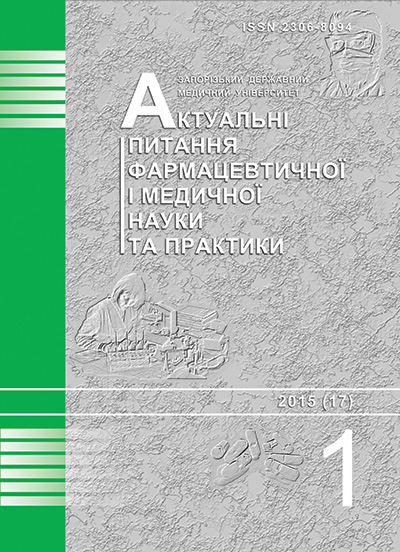Theoretical justification of basic structures for purposeful synthesis of potential antispasmodics
DOI:
https://doi.org/10.14739/2409-2932.2015.1.41340Keywords:
Parasympatholytics, Chemical Synthesis, Research, Chemical structureAbstract
Aim. Formation of the basic structures for virtual libraries is an important step during the docking studies, which are currently used in the search of new substances. For the purpose of the logical framework approach use in the planning stages of research we have analyzed the current assortment and mechanisms of action for drugs with spasmolytic action according to their chemical structure.
Results. It has been established that the most probable mechanism of action for amidated derivatives of 2-hydroxy-4-oxo-4H-pyrido [1,2a]pyrimidine-3-carboxylic acid, which are substituted in the pyridine ring, in the presence of similar structural fragments is the base inhibition of PDE.
References
Ukrainec, I. V., Tugabej, I. A., Bereznyakova, N. L., & Kravchenko, V. N., et al. (2008). 4-Gidroksihinolony-2. 144*. Alkil-, arilalkil- i arilamidy 2-gidroksi-4-okso-4N-pirido[1,2]pirimidin-3-karbonovoj kisloty i ih diureticheskie svojstva [4-Hydroxyquionolones-2. 144*. Alkyl-, arylalkyl- and arylamides of 2-hydroxy-4-oxo-4Н-pyrido[1,2]pirimidine-3-carboxylic acid and their diuretic properties]. Khimiya geterociklicheskikh soedinenij., 5, 718–729. [in Latvia].
Abu Shark, А. І. (2013). Vykorystannia poperednoho planuvannia v protsesi optymizatsii tsilespriamovanoho syntezu biolohichno aktyvnykh rechovyn v riadu pokhidnykh 2-hidroky-4-okso-4N-pirydo[1,2]-pirymidyn-3-karbonovoi kysloty [Using of preliminary planning in the process of optimization for the directed synthesis of biologically active substances in a range of 2-hydroxy-4-oxo-4H-pyrydo [1,2] pyrimidine-3-carboxylic acid derivatives]. Zbirnyk naukovykh prats spivrobitnykiv NMAPO imeni P.L. Shupyka, 22(4), 342–347. [in Ukrainian].
Pchelintsev, M. V. (2008). Spazmolitiki: ot klinicheskoj farmakologii do farmakoterapii [Spasmolytics: from clinic pharmacology to pharmacotherapy]. Lechashchij vrach, 7, 74–77. [in Russian].
Chou, R., Peterson, K., & Helfand, M. (2004) Comparative efficacy and safety of skeletal muscle relaxants for spasticity and musculoskeletal conditions: a systematic review. Journal of Pain Symptom Management, 28(2), 140–175. doi:10.1016/j.jpainsymman.2004.05.002.
Pauli, I., dos Santos, R. N., Rostirolla, D. C., Martinelli, L. K., Ducati, R. G., Timmers, L. F. S. M. et al. (2013). Discovery of new inhibitors of Mycobacterium tuberculosis InhA enzyme using virtual screening and a 3D-pharmacophore-based approach. J. Chem. Inf. Model., 53(9), 2390–401. doi: 10.1021/ci400202t.
Martínez-Vázquez, M. A., Vázquez-Elizondo, G., González-González, J. A., & Gutiérrez-Udave, R. (2012). Effect of antispasmodic agents, alone or in combination, in the treatment of Irritable Bowel Syndrome: systematic review and meta-analysis. Rev. Gastroenterol. Mex., 77(2), 82–90. doi: 10.1016/j.rgmx.2012.04.002.
Ge, Z., Yuan, Y., Zhang, S., Hou, X., Wang, J., Cai, J., et al. (2011). Efficacy and tolerability of two oral hyoscine butylbromide formulations in Chinese patients with recurrent episodes of self-reported gastric or intestinal spasm-like pain. International journal of clinical pharmacology and therapeutics, 49(3), 198–205. doi: 10.5414/CP201485.
Khalif, I. L., Quigley, E. M., Makarchuk, P. A., Golovenko, O. V., Podmarenkova, L. F., & Dzhanayev, Y. A. (2009). Interactions between symptoms and motor and visceral sensory responses of irritable bowel syndrome patients to spasmolytics (antispasmodics). Journal of Gastrointestinal and Liver Diseases, 18(1), 17–22.
Boeckxstaens, G., Clavé, P., Corazziari, E. S., & Tack, J. (2014). Irritable bowel syndrome: focus on otilonium bromide. Expert Rev. Gastroenterol. Hepatol., 8(2), 131–7. doi: 10.1586/17474124.2014.869477.
Jung H.A., Islam M.N., Lee C.M., Oh S.H., Leec, S., Junge, J. H., Choib, J. S. (2013). Kinetics and molecular docking studies of an anti-diabetic complication inhibitor fucosterol from edible brown algae Eisenia bicyclis and Ecklonia stolonifera. Chem. Biol. Interact., 206(1), 55–62. doi: 10.1016/j.cbi.2013.08.013.
Nedelcu, L., & Balescu, A. (2010). Efficiency of antispasmodic drugs in the irritable bowel syndrome. Clujul medical, 83, 21–22.
Sivashanmugam, M., Raghunath, C., & Vetrivel, U. (2013). Virtual screening studies reveal linarin as a potential natural inhibitor targeting CDK4 in retinoblastoma., J. Pharmacol. Pharmacother., 4(4), 256–64. doi: 10.4103/0976-500X.119711.
Forte, E., Pizzoferrato, M., Lopetuso, L., & Scaldaferri, F. (2012). The use of anti-spasmodics in the treatment of irritable bowel syndrome: focus on otilonium bromide, Eur. Rev. Med. Pharmacol. Sci., 16(1), 25–37.
Downloads
How to Cite
Issue
Section
License
Authors who publish with this journal retain copyright and grant the journal right of first publication with the work simultaneously licensed under a Creative Commons Attribution License that allows others to share the work with an acknowledgement of the work's authorship and initial publication in this journal.


